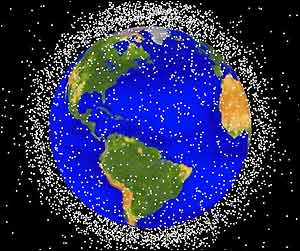Over a million particles orbit the Earth
 The space junk around the earth
The space junk around the earth
Although NASA is deeply investigating the theory of the impact from the insulating foam of the fuel tank, NASA does not believe that these blocks of foam, which are very light in weight, are the causes of the accident. Among other things, it was also hypothesized that in addition to the wing, there was also a problem with the carrier shaft of one of the wheels with which the shuttle lands and which is supposed to open after entering the atmosphere.
In a new theory emerging at NASA, officials at the agency claim that the fatal damage to the heat-resistant tiles may have been caused by an impact of space junk while in orbit.
The commander of the spaceship, Rick Husband, addressed the issue in June 2002 in an interview he gave me as part of the preparations for the film "Mission 107". In the interview, I asked Hasband whether in order to navigate a spaceship you have to constantly avoid asteroids like in the old computer game (this was, by the way, a warm-up question and the really serious questions came later, but in retrospect this is an important question). According to Husband, this is indeed NASA's number one concern and that its people use radar to track the dangerous debris, most of which are remnants of spaceships and satellites that have disintegrated, tools that have flown off shuttles and other industrial garbage. If there is any fear that the shuttle is going to collide with something, the shuttle engines are fired up and moved to another route.
This week, NASA Space Shuttle Flight Director Milt Haflin asked to check the possibility of an impact.
NASA engineers say they are considering the possibility that a small piece of space junk could have hit the shuttle, causing damage or even causing tiles to fall in such quantity that it could start a chain reaction when the spacecraft re-enters Earth's atmosphere.
During its time in orbit, NASA advises the shuttle crew on how to defend against this man-made debris, of which there are estimated to be a million orbiting the Earth. With the exception of 9,000 of them, most of these fragments are smaller than a tennis ball, but Halpin says his engineers have no solid evidence that Columbia was hit by such a fragment or by a micrometeorite.
However, there are some problems with this theory. Before each mission, the US Air Force and NASA perform analyzes of the shuttle's expected trajectory to ensure that it will not collide with known debris. The radar can detect the location and trajectory of fragments with a diameter of a few centimeters and, of course, larger ones. There are areas that are relatively free of crises and in one of them the space shuttle sailed on its last journey.
Also, if something hit the shuttle, the crew and computers would feel it. In the past, NASA had to adjust flight paths in flight (as the late Esbend described it) eight times to avoid collision with debris.
The impact of tiny fragments, at least so far it was believed, does not have a major impact on the safety of the flight. One study showed that objects that had been in space for over five years (and there are many such satellites) were hit by small fragments 30 thousand times, without this having any effect on their function.
In 1997, the US National Research Council said that NASA should conduct a risk assessment to assess the likelihood of a shuttle being irreversibly damaged by meteorites and space debris. The report states that although NASA takes steps to protect the spacecraft from orbital debris such as rocket debris, satellite debris and paint chips - there is a real risk that such a collision will cause the spacecraft to be disabled or harm the safety of the crew. The report added further and stated that space junk may cause damage during launch or return to the atmosphere and there is also a risk that "the crew will be hurt or that the spacecraft will not be able to deal with major damage." NASA should look into reducing the possible damage of space debris risk.
The report also stated that the shuttles, which were designed in the XNUMXs, were not designed to withstand the bombardment of space junk because such objects were not then recognized as an existential threat. All that remains now is to see if indeed space junk caused the accident, and it won't be easy because it is still impossible to restore the shuttle's cabin in any way.
Disintegration of the spaceship
* Return to Earth at a speed of 20 thousand km/h
* Disintegrated at an altitude of 65 kilometers
* The fragments were scattered over Texas and Louisiana - there are also reports of fragments in California and Arizona

2 תגובות
It's terrible and terrible!
I hope that the country will finally start to notice that it is not enough that there is garbage on the earth, we also polluted the space and thus took an innocent human life!
Terrible!
In the spirit of truth!!!!!!!!!!!!!!!!!!!!!!!!!!!!!!!!!!!! Ilan Ramon remembers him blessedly, his memory is in the spirit forever